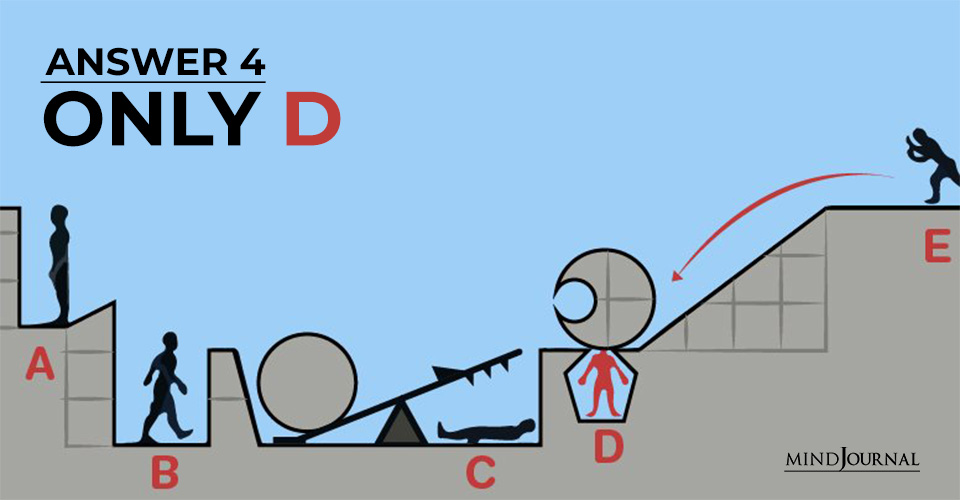Some riddles make you think, and others blow your mind. This one? It does both. If you love brain teasers, cause-and-effect puzzles, and chain reaction scenarios, then this challenge is for you.
The setup is simple—five individuals (A, B, C, D, and E) stand on a series of platforms, with E poised to push a large stone down a hill. But here’s the big question:
🔴 Who dies if ‘E’ pushes the stone?

At first glance, the answer might seem obvious. But when you dig deeper and analyze every possible reaction, you’ll realize that this riddle is much more complex than it appears.
Are you ready? Let’s break it down, explore the possible scenarios, and determine who meets their fate.
Understanding the Setup: The Domino Effect Begins
Let’s visualize the scene:
- Person E is standing on a platform at the highest point, ready to push the stone.
- Below, there are four individuals (D, C, B, and A) positioned at different points.
- There’s also a seesaw-like balance system and additional stones that could be triggered by the movement.
At first, it seems simple—E pushes the stone, it rolls down, and someone gets crushed. But in reality, this is a classic chain reaction problem where multiple outcomes are possible depending on the size of the stone, momentum, balance, and the position of the people below.
Scenario 1: The Stone Hits D and C
➡️ Most likely casualties: D and C

- The stone rolls down and directly crushes D and C, who are in its path.
- This scenario assumes no secondary movements—just a simple downhill trajectory.
- A and B remain safe because the stone doesn’t reach them.
But is it really that simple? Not quite.
Scenario 2: D, C, and E Die
➡️ Casualties: D, C, and E

- The first stone hits a balance mechanism, which sends another heavy rock flying upwards.
- That second rock rebounds toward E, knocking them off their platform.
- Meanwhile, D and C are still crushed by the initial rolling stone.
In this case, E’s action backfires, making them part of the casualties.
Scenario 3: D, C, and B Get Knocked Out
➡️ Casualties: D, C, and B

- The stone knocks over the seesaw, sending another object falling onto B.
- D and C still get crushed, but now B is dragged into the mess due to the reaction of the seesaw.
- A remains safe because the momentum doesn’t reach their platform.
This scenario is possible if the stone’s force extends beyond the initial impact point.
Scenario 4: Only D Dies
➡️ Casualties: Only D

- The stone rolls straight and only hits D, without triggering any additional reactions.
- C, B, and A remain safe because no other elements are affected.
This is the least chaotic outcome, but considering the balance system in play, it’s an unlikely result.
Scenario 5: Everyone Dies (D, C, B, and A)
➡️ Casualties: D, C, B, and A
- The rolling stone knocks over the seesaw, which then causes a series of falling rocks to be released.
- This triggers a domino effect, ultimately reaching A—the furthest individual.
- The entire setup collapses, leaving no survivors except E.
While this is a worst-case scenario, it shows how a single action can have massive unintended consequences.
So, Who Really Dies? The Most Likely Answer
After analyzing all possible scenarios, the most probable outcome is:
✔ D and C are definitely the first victims.
✔ E might also die if the balance causes another rock to rebound.
✔ B’s fate depends on the seesaw’s reaction.
✔ A likely survives unless a full chain reaction occurs.
However, the true beauty of this riddle is that the answer isn’t set in stone (pun intended). Your conclusion depends on how you interpret the mechanics of gravity, force, and momentum in the setup.
Why This Riddle Is So Fascinating
This challenge isn’t just about who dies—it’s about how cause and effect work in a complex system.
✔ It teaches critical thinking. Instead of assuming a direct answer, you have to break down every possible event.
✔ It highlights the butterfly effect. One small action (pushing a stone) can trigger unexpected consequences.
✔ It mimics real-life decision-making. Many choices we make have unintended ripple effects—some good, some bad.
Think You Have the Answer? Put Your Logic to the Test!
Now that you’ve seen the possibilities, what’s your final answer?
🧠 Who do you think meets their fate?
💡 Which chain reaction do you believe is most likely?
👀 Did we miss any possible outcomes?
Leave your thoughts in the comments—let’s see how many people can truly outthink this tricky riddle!